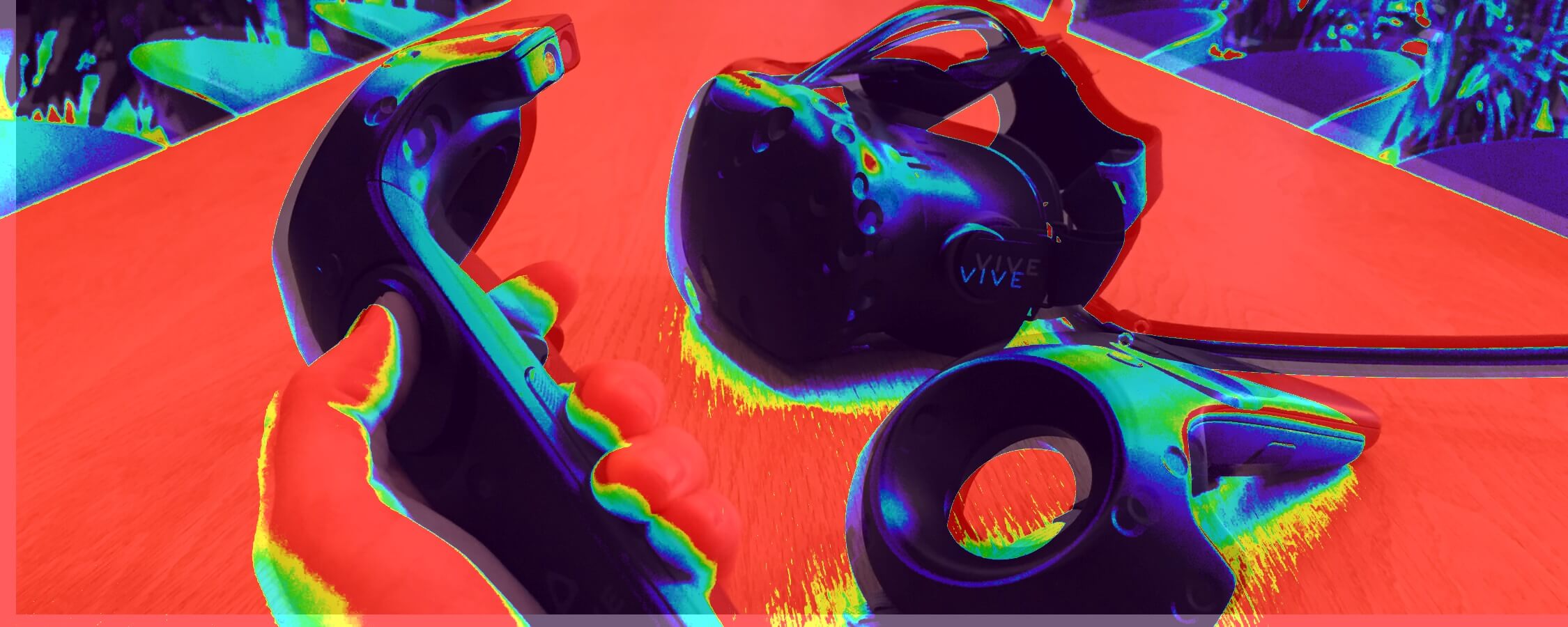 For the past five days, I've spent nearly as much time in virtual reality as real reality. My calves ache and my neck is sore, but all in all I've had a pretty good time. I've been using the Vive, an ambitious new virtual reality system created by HTC and Valve.
For the past five days, I've spent nearly as much time in virtual reality as real reality. My calves ache and my neck is sore, but all in all I've had a pretty good time. I've been using the Vive, an ambitious new virtual reality system created by HTC and Valve.
With the Vive set up in my living room, I've been everywhere from outer space to Aperture Science's stark white labs to a quiet beach where I just sat on the ground and listened to the waves. Like, I actually sat on the ground. With my own butt.
The Basics
Valve and HTC's Vive is the most immediately impressive (and imposing) VR headset on the market. It comes with a price to match: $800. For comparison's sake, the Oculus Rift is $600, though it will get touch controllers later this year that will probably bring it a lot closer to the Vive in terms of price and functionality. PlayStation VR will come in a $500 bundle when it launches later this year. And of course, the Vive's $800 price tag doesn't include the powerful gaming PC required to operate it---a pre-made system that meets the Vive's specs will easily cost you over $1000. I tested the Vive on a PC with a GeForce GTX 980 graphics card, an Intel i7 processor clocked at 2.9 GHz, and 32GB of RAM.
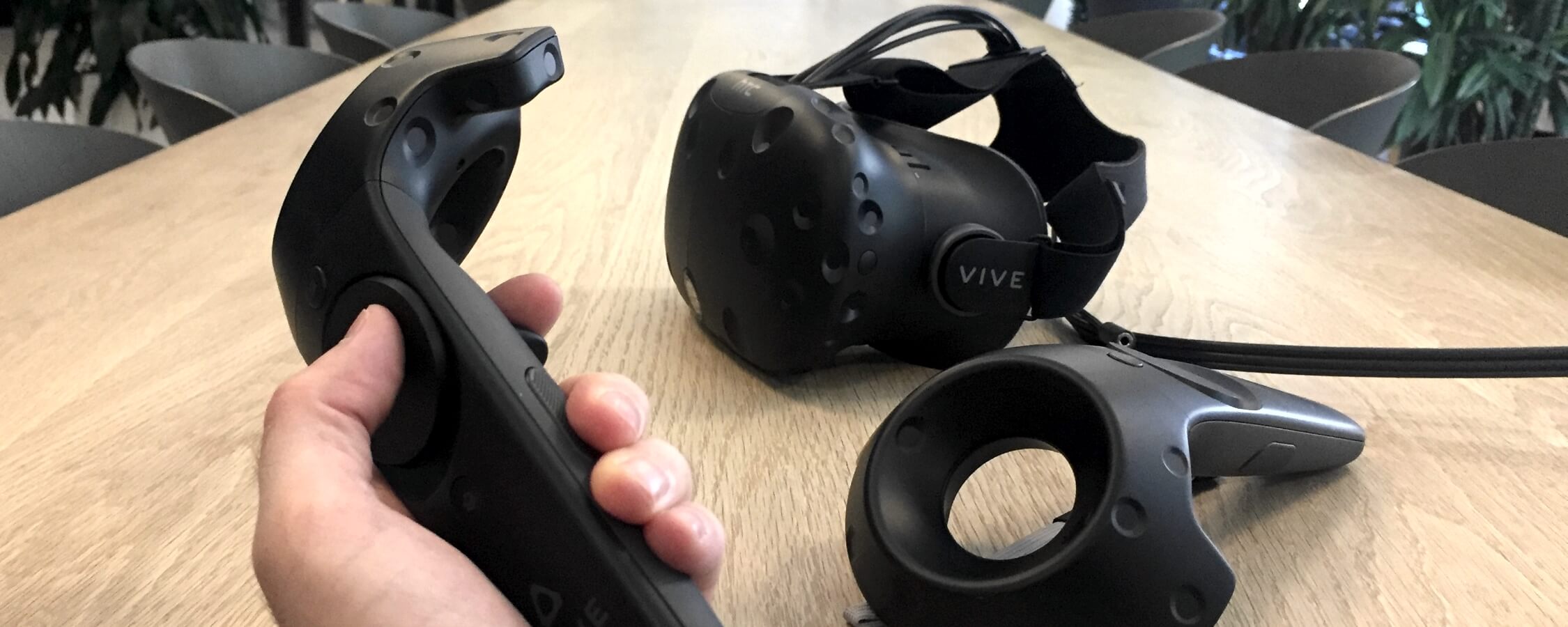
Once you've got the Vive headset, room sensors, and remote-shaped controllers synced and working, you can walk through a virtual space with your own legs and grab things with your own "hands." That's the key differentiator here: while the Oculus Rift and PlayStation VR have so far been largely focused on seated experiences, Vive is more focused on standing, walking, grabbing, and bopping. There's a bit of a naturalistic, Wii-like feeling to some of its games, in that respect-especially the ones about golf and tennis.
Gaming with the Vive is much more versatile than it was with the Wii a decade ago, mostly because the new VR headset and controllers put you inside the game you're motion-controlling. When it works, it's the closest thing we've got to virtual reality as imagined in sci-fi books and movies. It's tough to describe, but the sense of "there"-ness is unparalleled. You have hands and feet! You are the character. You see the virtual golf course all around you, wherever you look. You see virtual hands where your hands are. You can pick up a virtual putter and play. Before I got my Vive, I figured I'd be over that after a few days, that the sheen would fade into the background of my experience. That hasn't happened yet. I'm still knocked back when I enter a new place. I feel like I'm there.
Problem is, emulating reality isn't easy. It's predicated on the notion of everything coming together so perfectly as to fool your senses into believing you're somewhere you're not, someone you're not. The Vive is a young piece of hardware, and more to the point, the current software lineup feels like the Early Access version of a (potentially) much better experience. Speaking of...
Setup can be a pain.
The Vive can be fiddly as all hell. Its box is a cool sort of blue, conjuring warm feelings of afternoon skies and ice cream cloud wisps. I saw that box, and I was like, Man, I sure do feel calm right now. Maybe I'll never be angry, upset, or frustrated again! Then I opened it. It was divided into multiple compartments: one for the headset, one for the sensor boxes, one for the controllers, and one for the little box that connects them all to your computer. Beneath those sections? Wires and more wires.

The first thing I had to do was open my web browser and go to an HTC website. There, I downloaded a program that would guide me through the setup process. It estimated that the whole thing would take around 28 minutes. OK, I said to myself, this won't be so bad. In hindsight, I find the 28-minute estimate hilarious for two reasons: 1) it is extremely specific, 2) in my experience, it was extremely inaccurate. Setting up the Vive took me two hours, and I was cursing like the son of a sailor and a warlock the entire time.
The setup process itself was actually pretty straightforward. I had to plug in two small sensor boxes on opposite sides of my room and make sure they were about six feet off the ground (I used tables and boxes, but you can screw the sensors into your wall, if your landlord's cool with that), plug a special base station into my PC's USB and HDMI ports, and plug the headset into the base station. It was once everything was supposed to be up and running that things got difficult.
In order to use the Vive, you've got to designate a room space. It has to be at least 1.5 x 2m (5 x 6.5 feet). In that space, you can walk around freely. If you get too close to its boundaries, the Vive's "Chaperone" software will display a faint outline of a wall.
First, though, I had to make room for all of this. Just what I've always wanted,"a good reason to keep my apartment clean. Then I had to trace around the outer perimeter of the space I'd cleared with a controller, only to learn that I hadn't cleared enough space. So I pushed tables, chairs, and my bed as far against the walls of my tiny apartment as I could. Then I tried tracing the perimeter again, but the sensors kept losing track of my controller while I did it. At that point, I had to unplug the sensors, move them slightly, and try again until, finally, everything came together.

So I had my space. Done, right? Of course not! Every time I tried to start Steam's VR program, I was informed that it couldn't find my headset. "My headset is right here," I told my computer, pointing at the headset on my head. "I found it. It is found." With the help of Steam's VR troubleshooting page, I solved that issue by downloading some new drivers. After that, Steam VR found my headset, only to tell me that, essentially, it wasn't playing nice with my PC's HDMI port. At that point, I resolved to throw my Vive into the sun one day, after it's outlived its usefulness. Ultimately, I disconnected the headset from my PC and reconnected it a few times until, for some reason, it worked. I still have to do this occasionally when trying to play a Vive game. I grind my teeth a lot. I've begun to have trouble chewing tough meats.
I'm going into so much detail here because I really want to convey how many little annoying things can go wrong when setting up a Vive. Virtual reality is a daunting prospect with its high price point and, you know, the part where you have to wear a sweaty brick on your face. The barrier to entry is already prohibitively high. Setup needs to be as simple as possible for this thing to really catch on, and right now, the Vive simply isn't there. In all likelihood, Valve and HTC will refine the process, but in the present year of two-thousand-and-sixteen, it's a big, frustrating knock against an otherwise cool experience.
The headset fits kinda weirdly.
I've found myself having to adjust and readjust the Vive headset. Weight-wise, it's mostly fine (my neck only hurts because I've been marathoning VR games for multiple days in a row), but if I move my face too much by smiling, laughing, scrutinizing, or what have you, the front-heavy headset slides to a point where the lenses are out of focus. This becomes especially noticeable any time I'm trying to examine detailed in-game objects up close. Suddenly, it's all a blur. To solve the problem, all I have to do is reach up and pull the headset back into place, but having to do that every 5-10 minutes can get kinda annoying, not to mention immersion-breaking.
That said, when everything's in place, games look great. While none of its games pack the graphical punch of an ultra high-end PC game, they look decent enough that my brain buys the illusion. Despite the temptation to believe realer virtual reality = better, I've found that more stylized games are better at leaping the uncanny chasm. Games like Job Simulator, Irrational Exuberance, Hover Junkers, and Fantastic Contraption spirit my mind away to other places, whereas more realistic-looking experiences sometimes leave me thinking, "Huh, that texture looks awfully muddy up close," or "Why doesn't this cereal box tell me exactly how many calories are in every bite?"
There's some jank in the trank.
The Vive's sensors can be, well, sensitive. If they lose track of a controller, you might find that your in-game "hand" is suddenly floating off into the sunset, leaving you without so much as something to wave goodbye with. If they lose track of your headset, everything can suddenly disappear, paving your vision over with a sea of gray. I also encountered a few moments where my in-game view started shuddering, which is the first time any sort of video game has ever made me feel nauseous.
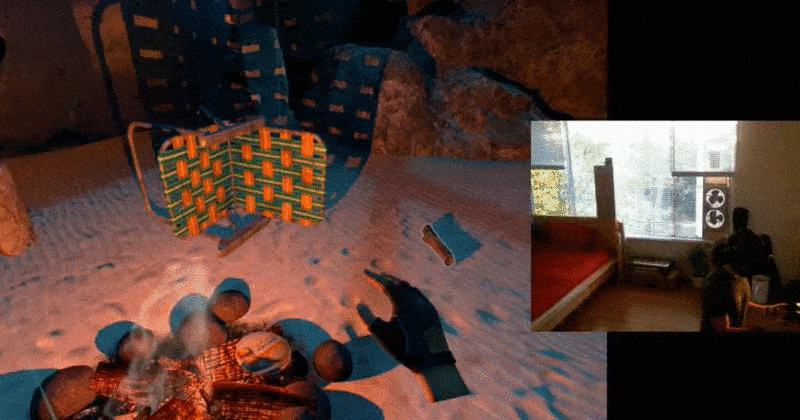
Sometimes, you just need to reposition your sensors a bit. Even with as close to an optimal setup as I've been able to get, I've still had to put up with a few moments of unexplained jankiness.
The microphone ain't great.
In his impressions of the Oculus Rift last week, my colleague Kirk Hamilton praised the Rift's built-in headphones and mic. The Vive, by contrast, doesn't have built-in headphones (you've gotta wear your own on top of the headset). You might not think that's a super huge deal, but it's one of those convenience features that impacts your experience more than you'd think.
The Vive's built-in mic is, well, crap. Listen to the audio on this video of Surgeon Simulator VR I tried to record:
It sounds like I'm talking through a tin can that's duct-taped to a 56k dial-up modem and run through a puberty filter. Sometimes my voice cuts out almost entirely for no apparent reason. It's basically unusable for recording videos or streaming games, and I wouldn't really recommend it for communicating in multiplayer games or chat programs either.
The cord, the cord, the corrrrrrrrrrrrrrd.
In order for the Vive to function, the headset must be plugged into a base station that plugs into your PC. This means that there's always a cord trailing behind you. It's plenty long, but it invariably gets in the way. Before long, I got used to stepping over it (so much so, in fact, that LOCATION OF CORD has become a weird sixth sense, a thing I've started subconsciously tracking), but it never stopped being... there.
Sure, it's a necessary evil, but it's distracting. Just when I got to feeling super immersed in Space Pirate Trainer right now, like I couldn't be more immersed if real space robots came and dunked my head in a toilet, I'd nearly trip over the cord. The illusion would shatter, and my robot-blasting fervor would fade. I wished my Space Pirate gun could shoot the cord, or at least teach it to feel pain. Fuck the cord.
All that said...
When it's working, Vive VR is astounding.
You might have heard people compare the Vive to Star Trek's famed Holodeck. It's definitely not that seamless (and I've yet to get shot or create a new species of photonic life in it), but in the Vive's best moments, the comparison is apt.
While playing the prelude to surreal space exploration game Irrational Exuberance, I remember staring slack-jawed as a planetoid came apart before my eyes, pieces hurtling toward me like shooting stars. How could I not? I was witnessing this otherworldly cosmic event, and I was there. Or at least, near enough to there that my brain decided, "Eh, good enough."
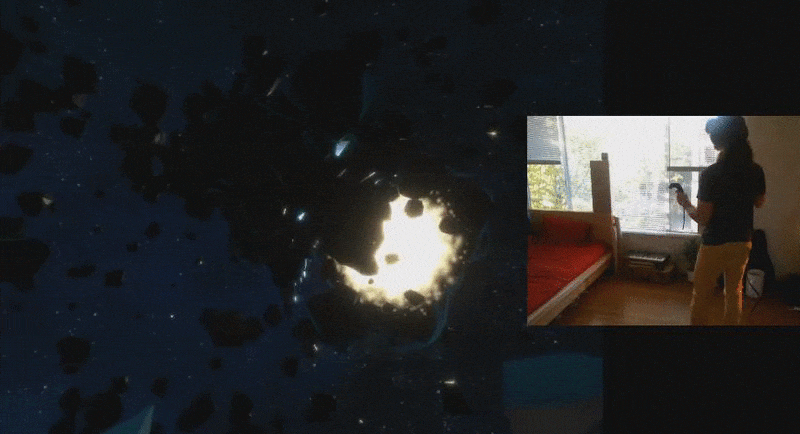
I swatted the baby asteroids with my "hands," producing a satisfying rumble from my controller, and watched as they split and sunk into infinity. Briefly, nothing else really mattered. In that moment, I was lost in the immenseness of the cosmos.
Then I stubbed my toe on my office chair and shouted, "FUCK!" just before I remembered it was 2 AM and my girlfriend was sleeping a few feet away. Ladies and gentlemen, I give you... The VR Experience.
For real, though, I can't remember the last time I said "wow" this many times in a week-long period. And it wasn't just when I was getting pelted with virtual space rocks.
The smallest interactions are the most impressive.
The most astounding moment I've had with the Vive involved a tin of popcorn.
I was playing the amazingly badly named adventure game The Gallery-Episode 1: Call of the Starseed, walking along an abandoned beach. Evening calm was intermittently interrupted by the crashing of waves, or the occasional caw of a seagull. I came across a campfire, also abandoned. Someone had been there recently, though. They left behind all sorts of stuff: a cooler, beer cans, chairs, a beach ball, even fireworks. I spotted a tin of unpopped popcorn and picked it up. On a lark, I held it over the fire. It began popping. Popping! That's the main thing popcorn does, except in video games, where usually it just sits in a state of sterile passivity until the end of time. I tried the fireworks. They blasted off into the evening sky. Then I shot one at the ground, because I wanted to see if getting third-degree burns in VR would also give me third-degree burns in real life.
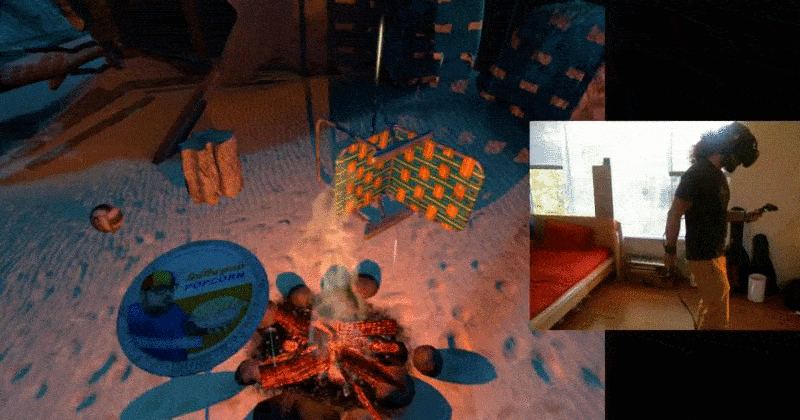
Later, I encountered a note full of sensitive information. I picked it up and read it. "It would be bad if this fell into the wrong hands," I thought to myself. Instinctively, I held it over a candle, and it burned to a crisp. The game never told me to do this, nor did it even imply it was possible. I just did it because, well, that's probably what I would do if such a situation occurred in real life.
By the same token, though, Vive VR games have a way of falling apart when they don't have that kind of internal consistency. Valve's own Vive launch game, The Lab, contains one of the most impressive VR vignettes out there. It's called Robot Repair, and it sees you... repair a robot for Portal's maniacal Aperture Science company. Early on, though, there's a bit where you find a drawer full of tiny silhouette people. When they see you, they decide you are their god, and the experiment becomes contaminated. You're instructed to close the drawer, at which point the tiny people are all incinerated. But one slips out and falls to the floor. Immediately, I tried to pick that one up. Nothing happened. I couldn't interact. Similarly, I couldn't pick up objects on nearby shelves.
In regular games, I wouldn't really care about any of that. But in Vive games, I have hands, damn it. My brain expects them to be able to reach out and touch, not pass through stuff as though I'm Casper The Impotent Ghost.
I've been having trouble telling virtual reality and real reality apart.
Not in the "seek help" sort of way, but like, OK: the other day I was talking with a friend about coffee cups. I had this really vivid recent memory of a bunch of coffee cups, and I couldn't place where it was coming from. I remembered picking up a bunch of them, reading their logos, peering into them, seeing some gnarly stains, etc. Had I been to a ceramics shop? No, last time I did that was while Christmas shopping last year. Maybe I was remembering doing the dishes? No, I haven't done that since Christmas last yea... I mean last week. Christmas last week.
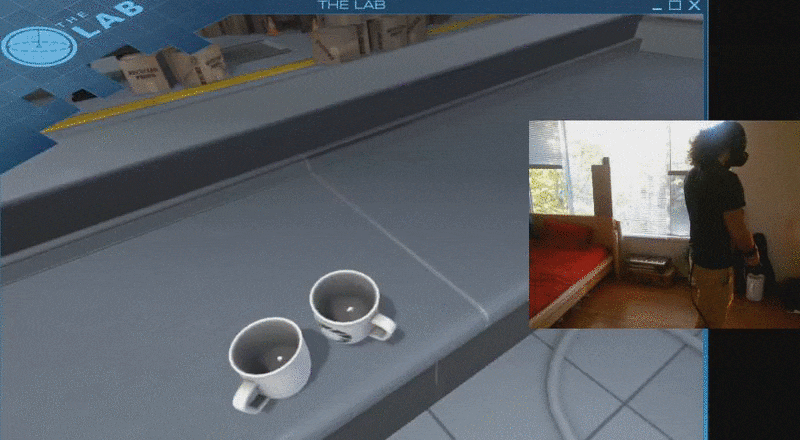
Then it hit me: my memory came from Valve's The Lab. In the game's hub area, there are a bunch of items you can examine, including very detailed coffee cups. That also explained why my coffee cup memory was tied so intrinsically to my memory of torturing a tiny man trapped in a jar.
Virtual/real-world confusion goes both ways, though. A couple days ago, I was playing Job Simulator, and my girlfriend was like, "Are you about ready to go to bed?" And I was like, "Oh, it's probably pretty late, huh? Totally." So I decided to exit VR and go to bed. Problem: I needed to take off the headset, but I was holding controllers in both hands. Solution: put the controllers on the table in front of me. Problem: the table was not real. Fortunately, this occurred to me about one second before I sent my controllers clattering down. I stopped myself just in time. Afterward I sent my brain to time-out.
So yeah, Vive VR can be really immersive. However...
Marathoning Vive games is physically exhausting.
Despite my career choice of Guy Who Spends Most Of His Waking Hours Playing, Writing About, Or Discussing Video Games, I'm in pretty good shape. I exercise daily, and I'm consumed by guilt when I can't make the time to do so. I say this because, well, I'm in a fair amount of pain right now. From playing video games.
On their own, typical Vive activities-walking, reaching, standing, occasionally kneeling-are not particularly intense. If you do these things every day in continuous 3-5 hour chunks for a week, though, don't be surprised if your neck, shoulders, knees, and calves start rebelling. See, people are great at walking and running, but with many Vive games, you actually spend most of your time standing still. The human body haaaaaaates that.

The Vive mileage I've put on my joints hasn't been debilitating, but it can become distracting. With really good games, it doesn't matter much, because I'm so into them. But yesterday I was playing Vanishing Realms, a Zelda-inspired dungeon crawler. It made a great first impression with intense sword-swinging combat against big ol' skeleton jerks, but my enthusiasm waned as the game's pacing took a dip. I got bored, and my mind began to wander. Before long, I realized that my legs were cramping, and my shoulders were tired, which compounded my distraction. Ultimately, I had to quit out and rest.
On the upside, you can configure the Vive so you can play games while sitting down, and it works just fine once you've moved your sensors closer together. Many Vive exclusives, however, are meant to be played standing. Just keep in mind that you're gonna have to take breaks. Right now, though, that's not a huge concern, because...
Many Vive games feel like they belong in Early Access.
Some of the games are in Early Access. The Vive's launch line-up is peppered with proto-games and glorified tech demos. I can count the number of games that feel like actual complete experiences on one hand.
In fact, I'll do it for you right now: 1) Fantastic Contraption is the best one, with tons of puzzles, great personality, and some brilliant construction mechanics. 2) Vanishing Realms isn't the best action-adventure game ever, but it's at least got a fair amount of Stuff to explore and do. 3) Job Simulator tells a dystopian tale through comedic future-robot takes on modern day drudgery. 4) Hover Junkers is a thrilling multiplayer shooter with awesome social features, though it's more mechanically complete than it is full of capital-C content. 5) The Gallery-Episode One: Call of the Starseed is the first episode of an adventure game that has solid puzzles and a coherent, well-voiced-acted narrative. It's pretty glitchy, though. 6) Tilt Brush isn't even a game, but it lets you paint sweet art on thin air, so I'm including it. 7) Elite Dangerous works as well with the Vive as it does with the Oculus Rift, and remains one of the most immersive things you can do in VR.

OK, two hands. But I'm only using a very small portion of the second hand.
In the past week I've played so many brief proof-of-concept demos that could (and maybe will) be great games with more development. Surgeon Simulator VR, Irrational Exuberance, #SelfieTennis, Unseen Diplomacy, Audioshield, Windlands, Space Pirate Trainer, even Valve's own The Lab---the list goes on.
It makes a degree of sense. As much as any other entity in software development, Valve has embraced the Early Access model. And why wouldn't small developers want their games leading the charge on an exciting new platform, like the Vive? In this case, it only becomes a problem when most of the games populating a vaunted 30-plus-game launch lineup feel incomplete or otherwise unsatisfying.
The best uses may not be games at all.
There's a lot in the pipe for VR that has nothing to do with video games. Some of it is already here. Kirk wrote about Virtual Desktop, which wraps your computer desktop around you in VR. I can confirm that it is, indeed, a super cool way to work, and also watch movies, TV, and uh, porn. Speaking of VR porn, that's already here too, and a whole lot more is on the way.

There's also stuff like AltSpace VR, which lets you hang out with people on the other side of the world as though you're in the same room. You can watch stuff together, explore, do karaoke, throw parties, and all sorts of other stuff. My girlfriend and I are probably gonna try using it to keep in touch while she's away in England for a few months. I don't know if it's actually gonna be any good, but it points to one of the many directions non-gaming VR could go. There's so much untapped potential here, and it's super exciting.
The Vive is really cool, but it's got a ways to go before it's essential.
The Vive's current game lineup prioritizes quantity over depth. Its coolest non-gaming applications remain largely theoretical, promises that will hopefully be fulfilled down the road. You'll likely need to upend your home's floorplan to use it, and the hardware can be finicky and tough to get working.
While the Vive's best moments are some of the coolest I've experienced in video games, I can't recommend purchasing it right now. You'd be spending $800 on something that's going to be much better after months' worth of software (and maybe even hardware) revisions, and there currently aren't enough great games to justify the investment.
The Vive really is something you should see for yourself, but if you want to try it, go to a store that's demoing it, or make friends with somebody who already ordered one. I'm excited about what the future holds for the Vive, but the future's not here yet.
